全表格形式形容词和副词比较级和高级
- 格式:doc
- 大小:248.50 KB
- 文档页数:5
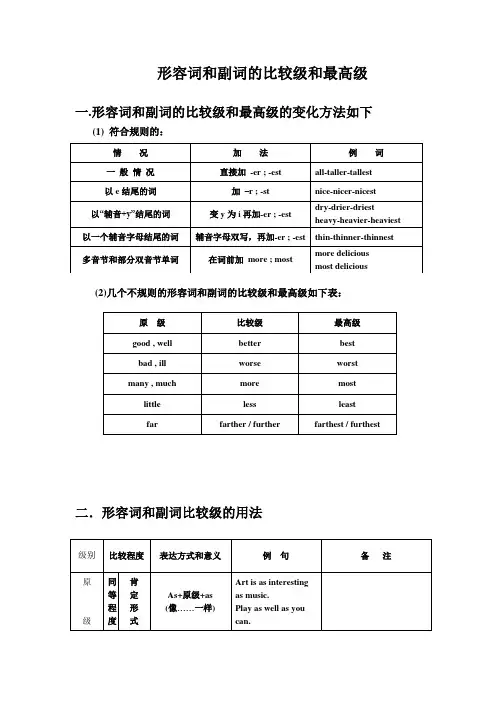
形容词和副词的比较级和最高级一.形容词和副词的比较级和最高级的变化方法如下(1) 符合规则的:(2)几个不规则的形容词和副词的比较级和最高级如下表:二.形容词和副词比较级的用法注意:有些形容词,如 dead, empty, round, sure, woolen 等受本身含义的限制,没有比较级。
例题解析1. He is ________ friends than I.A. much moreB. many moreC. very moreD. too more解析:后面有可数名词复数时,many的比较级形式为many more 修饰。
应选B.2. Which is the _________ country, Japan or Australia?A. more developedB. more developingC. most developedD. most developing解析:两者比较用比较级,表示"发达"用developed, 而developing 是"发展中的" 意思3. There were _______ shops in the city in 1982 than in 1990.A. littleB. fewC. fewerD. less解析:little 不能修饰可数名词,两者比较需用比较级,所以应选C.4. If you are not free today, come another day __________.A. tooB. soC. insteadD. yet解析:instead 作副词用时意为"代替,顶替",表示前面的事情没做,而是做了后面的事。
Instead一般位于句首。
应选C.5.He can't tell us ________, I think.A. important anythingB. anything importantC. important somethingD. something important.解析:不定代词与形容词联用需后置,否定句中应该用anything而不是something. 因此应选B6. The Huang River is the second __________ river in our country.A. longB. longerC. longestD. the longest解析:"定冠词the+ 序数词+ 形容词最高级" 表示"第几大……" 应选C.7. The light in the office wasn't ________for him to read.A. enough brightB. bright enoughC. brightlyD. enough brightly解析:enough修饰名词时可前可后,修饰形容词或副词时,要后置。
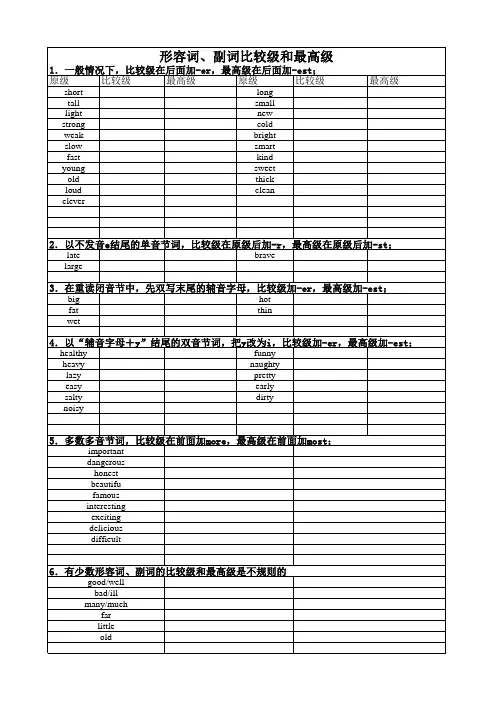
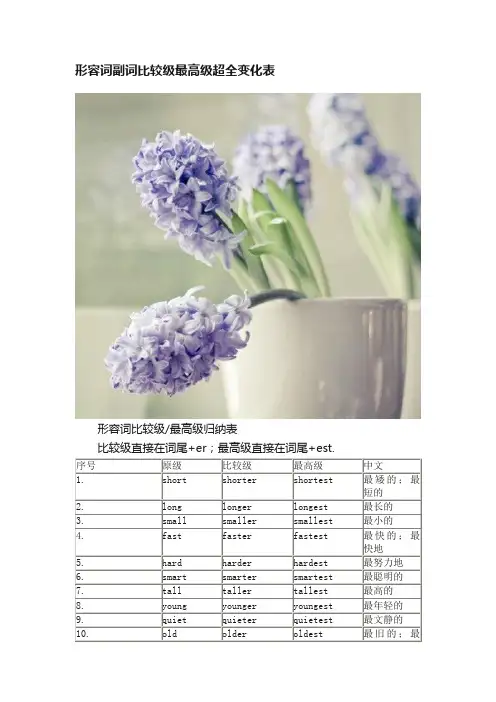
形容词副词比较级最高级超全变化表形容词比较级/最高级归纳表比较级直接在词尾+er;最高级直接在词尾+est.以不发音e结尾的单音节词,比较级直接加---r;最高级直接加---st.字母,然后比较级加---er;最高级加---est。
要将“y”改为“i”后,比较级加---er;最高级加---est。
其他双音节词和多音节词变比较级在原级前加more;变最高级在原级前加most。
其他双音节词和多音节词变比较级在原级前加more;变最高级在原级前加most。
特别提醒:以形容前缀un构成的三音节形容词不适合上述情况,如:unhappy- unhappier- unhappiest, untidy- untidier- untidiest以形容词+ly构成的副词要在前面加 more,most如:slowly - more slowly- most slowlyquickly - morequickly- most quickly注意:early - earlier- earliest由ing分词和-ed分词演变过来的形容词(包括不规则动词如know→known)只能加more或most来表示它们的比较级和最高级。
interesting - more interesting -most interestingexcited - more excited - most excitingtired - more tired - most tiredboring - more boring - most boring不规则变化* further不仅可以指“距离更远”,还可指“程度更深”。
记住以下三个词组:further study(进修) further education(继续教育) further information (进一步的信息)* elder仅用于同辈之间的排行,如: elder sister(姐姐) elderbrother (哥哥)* less作为“更少”仅用来修饰不可数名词,修饰可数名词表示“更少”要用fewer。

形容词、副词的比较级和最高级一.形容词和副词的比较级和最高级的变化方法如下(1)符合规则的:(2)几个不规则的形容词和副词的比较级和最高级如下表:.形容词和副词比较级的用法.形容词副词比较级最高级的其他用法(1)和冠词连用the +形容词原级+ v(复),指一类人或物 the +形容词比较级,指两者中较…的”的那一个,eg. the youn ger of the a/ an +形容词比较级 eg. The pen is expensive. I want a cheaper one. (a) + most +形容词最高级非常…” eg. a most beautiful city(2)相关结构a.原级比较: 肯定句 as ….as ….否定句 not so / as ….as ….b.比较句: 比较级 + than …或 more (less) ….than …..The furn iture in this shop is less beautiful tha n that in that shop. c.比较级+ and +比较级 或 more and more+比较级 越来越…”richer and richer, more and more in terest ing d. The more …..,the more越•…,“越…”The more you look at the picture, the better you will like it. e.比较级+ than 「any other + n.(单)(适用于范围一致时)J (all) other + n.(复)jI any + n.(单)(适用于范围不一致时)He is taller than 「any other student / all other students in his class. I any student in my class. f.倍数表达法。
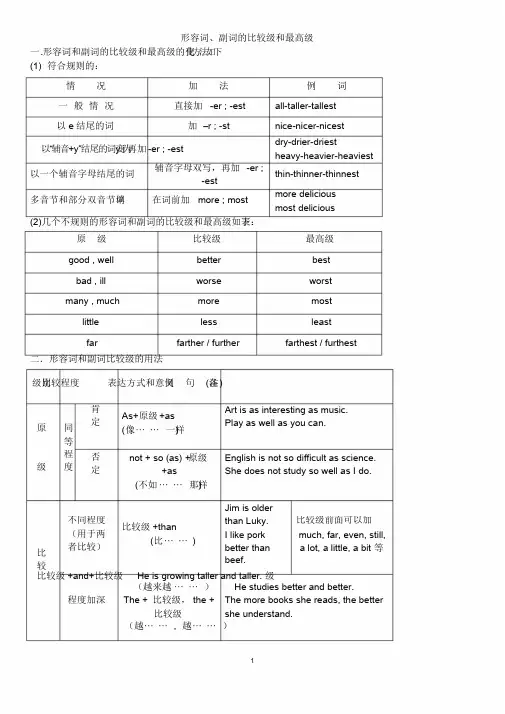
形容词、副词的比较级和最高级一.形容词和副词的比较级和最高级的变化方法如下(1) 符合规则的:情况加法例词一般情况直接加-er ; -est all-taller-tallest以e 结尾的词加–r ; -st nice-nicer-nicest以“辅音+y”结尾的词变y为i再加-er ; -est dry-drier-driestheavy-heavier-heaviest以一个辅音字母结尾的词辅音字母双写,再加-er ;-estthin-thinner-thinnest多音节和部分双音节单词在词前加more ; most more delicious most delicious(2)几个不规则的形容词和副词的比较级和最高级如下表:原级比较级最高级good , well better bestbad , ill worse worst many , much more most little less leastfar farther / further farthest / furthest 二.形容词和副词比较级的用法级别比较程度表达方式和意义例句(备注)原同肯定As+原级+as(像⋯⋯一样)Art is as interesting as music.Play as well as you can.等级程度否定not + so (as) +原级+asE nglish is not so difficult as science.She does not study so well as I do.(不如⋯⋯那样)Jim is older比较不同程度(用于两者比较)比较级+than(比⋯⋯)t han Luky.I like porkbetter thanbeef.比较级前面可以加much, far, even, still,a lot, a little, a bit 等比较级+and+比较级He is growing taller and taller. 级(越来越⋯⋯)He studies better and better.程度加深The + 比较级,the + The more books she reads, the better比较级she understand.(越⋯⋯, 越⋯⋯)1最高级最高程度(用于三者或三者以上)The +最高级+of (in)(最⋯⋯)Spring is the best season ofthe year.Lin Tao jumped (the)farthest of all.副词最高级前面的the 往往省略三.形容词副词比较级最高级的其他用法( 1)和冠词连用the +形容词原级+v(复),指一类人或物the +形容词比较级,指两者中“较⋯的”的那一个,eg. the younger of thea/ an +形容词比较级eg. The pen is expensive. I want a cheaper one.( a) +most+形容词最高级“非常⋯”eg. a most beautiful city( 2 ) 相关结构a. 原级比较:肯定句as⋯.as ⋯.,否定句not so / as⋯.as ⋯..b.比较句:比较级+than ⋯或.more (less) ⋯.than ⋯..The furniture in this shop is less beautiful than that in that shop.c.比较级+and+比较级或more and more+比较级“越来越⋯”richer and richer, more and more interestingd. The more ⋯.., the more 越⋯⋯.. ,“越⋯”The more you look at the picture, the better you will like it.e. 比较级+than any other +n. (单)(适用于范围一致时)(all) other +n.(复)any +n.(单) (适用于范围不一致时)He is taller than any other student / all other students in his class.any student in my class.f. 倍数表达法。

形容词比较级最高级的不规则变化表一、少数单音节词前面加 more-, most—构成比较级和最高级tired ——-- more tired , most tiredfond -———- more fond , most fondglad —---— more glad , most gladbored --—— more bored , most boredpleased—--- more pleased , most pleased二、不规则变化good /well———--—— better ,bestbad/badly/ill—-—--— worse , worstmany/much——-—-——more , mostlittle —---—— less , leastfar --—— farther, farthes / further , furthestold —-—— older , oldest (GA)—-—- older , oldest / elder , eldest (GB)三、下列形容词和副词的比较级和最高级有两种形式cruel————- crueler, cruelest /more cruel , most cruelstrict-—-— stricter , strictest /more strict , most strictoften-——-- oftener , oftenest /more often , most oftenfriendly--———— friendlier , friendliest /more friendly , most friendlyclever————- cleverer, cleverest /more clever , most clever四、下列形容词和副词没有比较级和最高(即表示”最高程度”或"绝对状态”的形容词和副词没有比较级和最高级)empty , wrong , perfect , unique , extreme , excellent , favourite (GB)/ favorite (GA) , true ,right , correct , extremely ..。
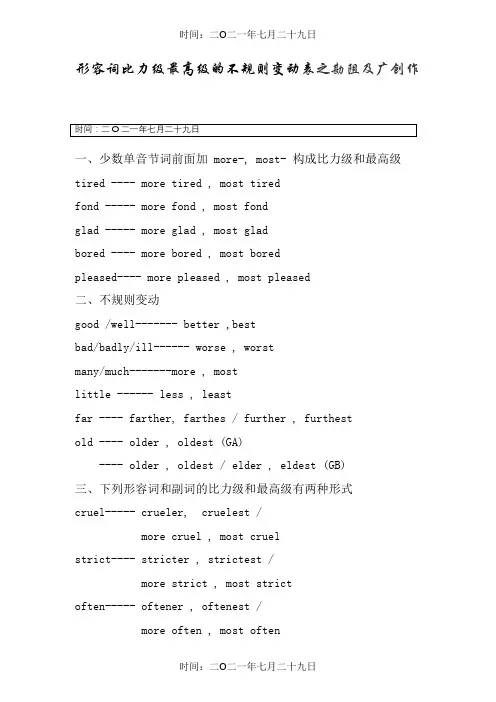
形容词比力级最高级的不规则变动表之勘阻及广创作一、少数单音节词前面加 more-, most- 构成比力级和最高级tired ---- more tired , most tiredfond ----- more fond , most fondglad ----- more glad , most gladbored ---- more bored , most boredpleased---- more pleased , most pleased二、不规则变动good /well------- better ,bestbad/badly/ill------ worse , worstmany/much-------more , mostlittle ------ less , leastfar ---- farther, farthes / further , furthestold ---- older , oldest (GA)---- older , oldest / elder , eldest (GB)三、下列形容词和副词的比力级和最高级有两种形式cruel----- crueler, cruelest /more cruel , most cruelstrict---- stricter , strictest /more strict , most strictoften----- oftener , oftenest /more often , most oftenfriendly------ friendlier , friendliest /more friendly , most friendlyclever----- cleverer, cleverest /more clever , most clever四、下列形容词和副词没有比力级和最高(即暗示”最高水平”或”绝对状态”的形容词和副词没有比力级和最高级)empty , wrong , perfect , unique , extreme , excellent , favourite (GB)/ favorite (GA) , true , right , correct , extremely ...。
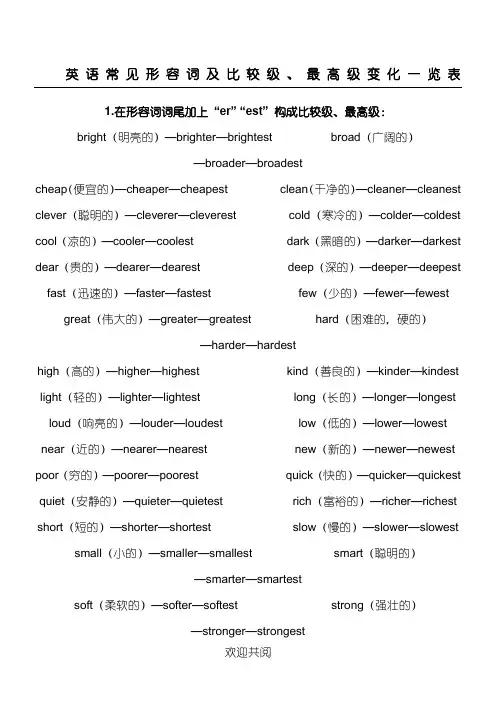
英语常见形容词及比较级、最高级变化一览表1.在形容词词尾加上“er” “est” 构成比较级、最高级:bright(明亮的)—brighter—brightest broad(广阔的)—broader—broadestcheap(便宜的)—cheaper—cheapest clean(干净的)—cleaner—cleanest clever(聪明的)—cleverer—cleverest cold(寒冷的)—colder—coldest cool(凉的)—cooler—coolest dark(黑暗的)—darker—darkest dear(贵的)—dearer—dearest deep(深的)—deeper—deepest fast(迅速的)—faster—fastest few(少的)—fewer—fewest great(伟大的)—greater—greatest hard(困难的,硬的)—harder—hardesthigh(高的)—higher—highest kind(善良的)—kinder—kindest light(轻的)—lighter—lightest long(长的)—longer—longest loud(响亮的)—louder—loudest low(低的)—lower—lowest near(近的)—nearer—nearest new(新的)—newer—newest poor(穷的)—poorer—poorest quick(快的)—quicker—quickest quiet(安静的)—quieter—quietest rich(富裕的)—richer—richest short(短的)—shorter—shortest slow(慢的)—slower—slowest small(小的)—smaller—smallest smart(聪明的)—smarter—smartestsoft(柔软的)—softer—softest strong(强壮的)—stronger—strongestsweet(甜的)—sweeter—sweetest tall(高的)-taller-tallest thick(厚的)—thicker—thickest warm(温暖的)—warmer—warmest weak(弱的)—weaker—weakest young(年轻的)—younger—youngest2.双写最后一个字母,再加上“er” “est” 构成比较级、最高级:big(大的)—bigger—biggest fat(胖的)—fatter—fattesthot(热的)—hotter—hottest red(红的)—redder—reddest sad(伤心的)—sadder—saddest thin(瘦的)—thinner—thinnest wet(湿的)—wetter—wettest mad(疯的)—madder—maddest3.以不发音的字母e结尾的形容词,加上“r” “st” 构成比较级、最高级:able(能干的)—abler—ablest brave(勇敢的)—braver—bravest close(接近的)—closer—closest fine(好的,完美的)—finer—finest large(巨大的)—larger—largest late(迟的)—later—latest nice(好的)—nicer—nicest ripe(成熟的)—riper—ripest rude(粗鲁的)—ruder—rudest safe(安全的)—safer—safest strange(奇怪的)—stranger—strangest wide(宽广的)—wider—widest wise(睿智的,聪明的)—wiser—wisest white(白的)—whiter—whitest4.以字母y结尾的形容词,把y改为i,再加上“er” “est” 构成比较级、最高级:busy(忙碌的)—busier—busiest dirty(脏的)—dirtier—dirtiest dry(干燥的)—drier—driest early(早的)—earlier—earliest easy(容易的)—easier—easiest friendly(友好的)—friendlier—friendliestfunny(好玩的)—funnier—funniest happy(开心的)—happier—happiesthealthy(健康的)—healthier—healthiest heavy(重的)—heavier—heaviest hungry(饿的)—hungrier—hungriest lazy(懒惰的)—lazier—laziest lucky(幸运的)—luckier—luckiest naughty(调皮的)—naughtier—naughtiestnoisy(嘈杂的)—noisier—noisiest pretty(美丽的)—prettier—prettiest silly(傻的)—sillier—silliest spicy(辣的)—spicier—spiciest thirsty(渴的)—thirstier—thirstiest ugly(丑的)—uglier—ugliest 5.双音节、多音节形容词,在单词前面加上“more” “most” 构成比较级、最高级:afraid(害怕的)—more afraid—most afraidbeautiful(美丽的)—more beautiful—most beautifulcareful(仔细的)—more careful—most carefulcheerful(开心的)—more cheerful—most cheerfulcrowded(拥挤的)—more crowded—most crowdeddangerous(危险的)—more dangerous—most dangerousdelicious(美味的)—more delicious—most deliciousdifficult(困难的)—more difficult—most difficultexciting(令人兴奋的)—more exciting—most excitingexpensive(昂贵的)—more expensive—most expensivefamous(著名的)—more famous—most famousfrightened(受惊的)—more frightened—most frightenedfrightening(令人害怕的)—more frightening—most frighteninghard-working(勤奋的)—more hard-working—most hard-workinghelpful(有帮助的)—more helpful—most helpfulhonest(诚实的)—more honest—most honestimportant(重要的)—more important—most importantinteresting(有趣的)—more interesting—most interestingpolite(有礼貌的)—more polite—most politeterrible(可怕的)—more terrible—most terribletired(累的)—more tired—most tired6.不规则变化的形容词:bad(坏的)—worse—worstfar(远的)—farther—farthest (far—further—furthest)good(好的)—better—bestill(病的)—worse—worstlittle(少的)—less—leastmany(多的)—more—mostmuch(多的)—more—mostold(年老的)—older—oldest ( old—elder—eldest)well(好的,身体好的)—better—best形容词的比较级和最高级: 形容词的比较级和最高级形式是在形容词的原级形式的基础上变化的。
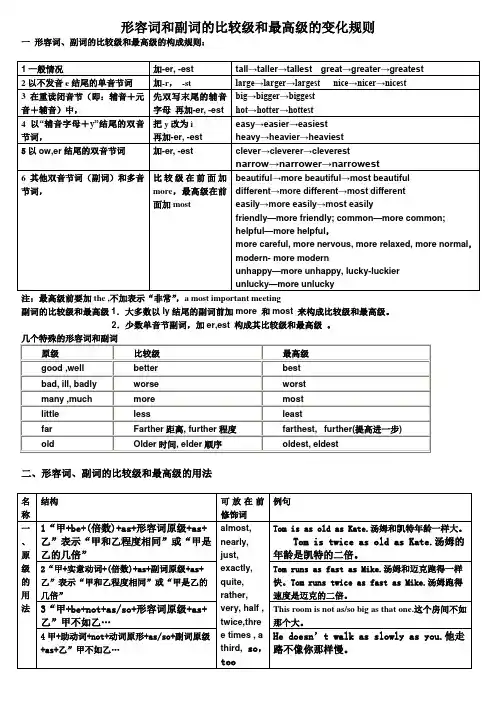
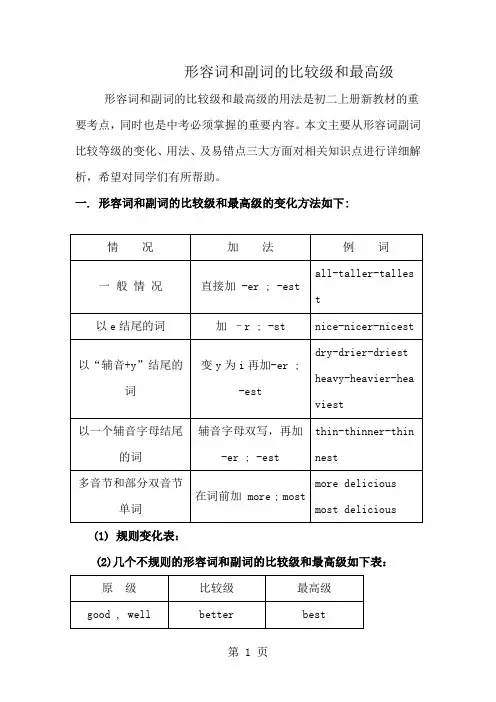
形容词和副词的比较级和最高级形容词和副词的比较级和最高级的用法是初二上册新教材的重要考点,同时也是中考必须掌握的重要内容。
本文主要从形容词副词比较等级的变化、用法、及易错点三大方面对相关知识点进行详细解析,希望对同学们有所帮助。
一. 形容词和副词的比较级和最高级的变化方法如下:(1) 规则变化表:(2)几个不规则的形容词和副词的比较级和最高级如下表:二.形容词和副词比较级的基本用法注:如果动词是及物或不及物动词,则后面用副词;如果后面是连系动词,则后面用形容词。
如:This car is the fastest of the four.(形容词)(这辆汽车是四辆之中最快的)This car runs (the) fastest of the four.(副词)(这辆汽车是四辆之中跑得最快的)三.形容词副词比较级最高级的特殊用法(1)和冠词连用the +形容词原级+v(复),指一类人或物the +形容词比较级,指两者中“较…的”的那一个,eg. the younger of the twoa/ an +形容词比较级eg. The pen is expensive. I want a cheaper one.( a) +most+形容词最高级“非常…”eg. a most beautiful city(2)序数词及最高级连用,如:Flying is the fastest and the second cheapest way to travel.(3)比较级+than any other +n. (单)(适用于范围一致时)(all) other +n.(复)any +n.(单) (适用于范围不一致时) He is taller than any other student / all other students in his class.any student in my class.(4)倍数表达法。

形容词和副词的比较级和最高级表格篇一:最全表格形式形容词和副词比较级和最高级形容词和副词的比较级和最高级的变化规则一形容词、副词的比较级和最高级的构成规则:注:最高级前要加the ,不加表示“非常”,a most important meeting副词的比较级和最高级1.大多数以ly结尾的副词前加more 和most 来构成比较级和最高级。
2.少数单音节副词,加er,est 构成其比较级和最高级。
二、形容词、副词的比较级和最高级的用法篇二:表格形式形容词和副词比较级和最高级形容词和副词比较级和最高级一形容词、副词的比较级和最高级的构成规则:注:最高级前要加the ,不加表示“非常”,a most important meeting副词的比较级和最高级1.大多数以ly结尾的副词前加more 和most 来构成比较级和最高级。
2.少数单音节副词,加er,est 构成其比较级和最高级。
二、形容词、副词的比较级和最高级的用法篇三:形容词和副词的比较级和最高级形容词和副词的比较级和最高级一、形容词和副词的比较级和最高级的变化方法如下(1) 符合规则的:(2)几个不规则的形容词和副词的比较级和最高级如下表:二、形容词和副词比较级的用法注意:有些形容词,如dead, empty, round, sure, woolen 等受本身含义的限制,没有比较级。
例题解析1. He has ________ friends than I.A. much moreB. many moreC. very moreD. too more解析:后面有可数名词复数时,many的比较级形式为many more 修饰。
应选B.2. Which is the _________ country, Japan or Australia?A. more developedB. more developingC. most developedD. mostdeveloping解析:两者比较用比较级,表示发达用developed, 而developing 是发展中的意思3. There were _______ shops in the city in 1982 than in 1990.A. littleB. fewC. fewerD. less解析:little 不能修饰可数名词,两者比较需用比较级,所以应选C.4. The Huang River is the second __________ river in our country.A. longB. longerC. longestD. the longest解析:定冠词the+ 序数词+ 形容词最高级表示第几大…… 应选C.三、形容词副词比较级最高级的其他用法( 1 )和冠词连用the +形容词原级+n.(复),指一类人或物the +形容词比较级,指两者中“较…的”的那一个,eg. the younger of the twoa/ an +形容词比较级eg. The pen is expensive. I want a cheaper one.( a) +most+形容词最高级“非常…” eg. a most beautiful city( 2 ) 相关结构1) 原级比较:肯定句as….as…., 否定句not so / as….as…..2) 比较句:比较级+than….或more (less) ….than…..The furniture in this shop is less beautiful than that in that shop.(注意代词that的用法)3) 比较级+and+比较级或more and more+比较级“越来越… ”richer and richer, more and more interesting4) The more….., the more…..“越…,越…”The more you look at the picture, the better you will like it.5) 比较级+than any other +n. (单)(all) other +n.(复)(适用于范围一致时)any +n.(单) (适用于范围不一致时)He is taller than any other student / all other students in his class. He is taller than any student in my class.6) 倍数表达法。
比较级和最高级的变化规则表格总结比较级和最高级是我们学习中文语法的重要部分,它们在句子中用来对两个或多个事物进行比较。
在中文中,比较级的构成通常是在形容词或副词之前加上“更”或“较”,最高级则通常在形容词或副词之前加上“最”。
比较级和最高级的变化规则是我们需要掌握的基本知识,下面我将会对比较级和最高级的变化规则进行总结,并共享一些我个人的观点和理解。
我们来看一下比较级和最高级的基本构成规则:比较级的构成规则:形容词/副词 + 更/较 + 原级 + 的 + 名词例:这本书比那本书更有趣。
最高级的构成规则:形容词/副词 + 最 + 原级 + 的 + 名词例:这是我最喜欢的一本书。
接下来,我们来总结一下比较级和最高级的变化规则,以便更深入地理解:1. 单音节词和部分双音节词的比较级和最高级的变化规则:- 比较级:原级 + er- 最高级:原级 + est例:old - older - oldest2. 部分双音节词和多音节词的比较级和最高级的变化规则:- 比较级:more + 原级- 最高级:most + 原级例:beautiful - more beautiful - most beautiful3. 特殊形式的比较级和最高级的变化规则:- 比较级:good - better- 最高级:good - best例:She is a better player than I am.通过以上总结,我对比较级和最高级的变化规则有了更全面、深刻的理解。
在实际运用中,我们需要根据词语的词性和音节数来灵活运用比较级和最高级的变化规则,以达到更准确、丰富的表达。
我们也要注意一些特殊形式的比较级和最高级,加强对这些词语的记忆和运用。
对于我个人来说,比较级和最高级的变化规则在写作和交流中起着至关重要的作用。
通过掌握这些规则,我可以更准确、更生动地描述事物之间的差异和优劣,使我的表达更加丰富有力。
在学习中文的过程中,我也深感比较级和最高级的变化规则是我们需要反复练习和应用的知识点,只有通过不断的实践才能真正掌握这一语法知识。